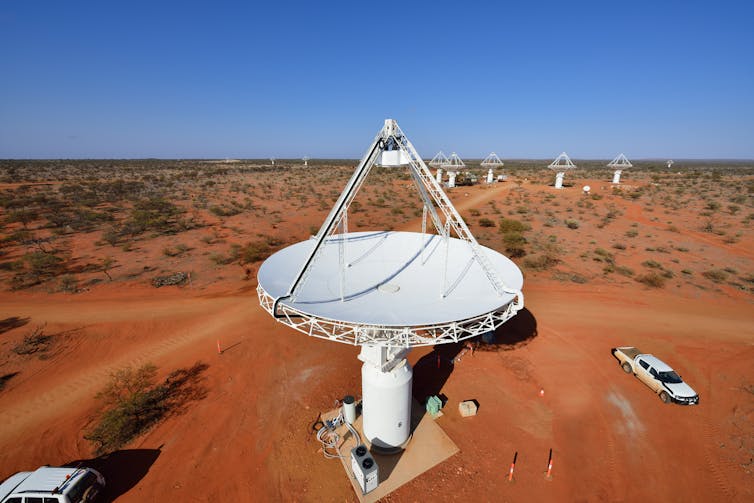Money for telescopes and vaccines is great, but the budget's lack of basic science funding risks leaving Australia behind
- Written by John Shine, President, Australian Academy of Science; Laboratory Head, Garvan Institute
The story of the past year has been the pandemic: from the first outbreaks in early 2020, the identification of the SARS-CoV-2 virus and methods to detect it, through to lockdown and quarantine measures, vaccine development, testing and finally distribution. The pandemic is not over, but the recovery has started.
At each stage, it has been scientists and researchers at the forefront of a rapid and successful national and global response to the pandemic. A nation’s capacity to respond to threats like a pandemic does not exist in a vacuum. It depends on scientists. You can’t research a solution without researchers.
In Australia, the higher education sector performs the vast bulk of research, including basic foundational research. This sector has been hit extremely hard by the pandemic, losing billions in revenue leading to the loss of research capacity — the very capacity we need to continue to respond to the pandemic and recover.
For this reason, the lack of recognition for science and scientists in the federal budget, and in particular for the foundational capacity in basic discovery science, is perplexing indeed. Such science capability underpins Australia’s resilience, not just against pandemics but also against natural disasters, economic shocks, technology disruption, the needs of an ageing population, and cyber warfare – many of the government’s stated priority areas.
There is some new funding in the budget, which is welcome. Initiatives such as support for the Square Kilometre Array radiotelescope, supporting women in STEM, climate adaptation, clean energy and government digital resources are essential additions to the Australian scientific landscape. The proposed patent box system promises to stimulate investment in Australian science in medical technologies and clean energy.
Read more: Cuts, spending, debt: what you need to know about the budget at a glance
Much of this funding is for incremental, short-term, focused technology programs. But such mission-directed science, while worthy, does not substitute for discovery science. If the government wants these missions to be effective, it must invest in basic science too.
 The SKA Pathfinder telescope in the Western Australian outback is a precursor to the full-scale Square Kilometre Array.
CSIRO/Dragonfly Media
The SKA Pathfinder telescope in the Western Australian outback is a precursor to the full-scale Square Kilometre Array.
CSIRO/Dragonfly Media
If universities are being asked to pivot away from over-reliance on international student income, and towards research commercialisation, there must be a basic science pool to help fuel this translation of research findings into commercial outcomes. At the risk of mixing metaphors, the pivot will be ineffective without a pipeline.
More importantly, the budget does nothing to stem the loss of university science jobs. Failure to act on university funding before the start of the 2022 academic year will mean more university job losses – and it is clear from the decisions already taken at ANU (in science and medicine), Melbourne, Macquarie and Murdoch that these cuts will come from science research.
While the government has not revealed in the budget how much money it has committed to onshore mRNA vaccine manufacturing, it is welcome news that there is commitment to developing this capability that will serve the nation well for decades.
The Australian Academy of Science is pleased the government has heeded our advice to future-proof Australia by developing this capability. It will allow Australia to build resilience against future pandemics and potential biosecurity threats that require us to have the onshore capacity to mass-produce vaccines.
Australia will require significant capability development alongside a manufacturing facility. A pipeline of knowledge will need to be developed, from fundamental to applied research related to mRNA vaccines and therapeutics. Australia will need a nationwide consortium of multidisciplinary expertise, in everything from data science to materials engineering, to become a world leader in this new technology.
Building our research capability in this area will allow us to continue solving existing challenges with mRNA vaccines. That’s why the science sector must be included in the scoping and investment in this new capability.
Read more: Did someone drop a zero? Australia's digital economy budget spend should be 10 times bigger
When I was appointed president of the Australian Academy of Science in 2018, I spoke about how it can take decades to translate the outcomes of basic research into something of real value for the community. This remains the case. It has always been the case.
Often, our political leaders want instant answers to the big questions. Australia’s science and research community delivered when it came to COVID-19, but it must be supported and funded to continue making fundamental discoveries if it is to deliver again. The future prosperity of our nation depends on it.
Authors: John Shine, President, Australian Academy of Science; Laboratory Head, Garvan Institute





